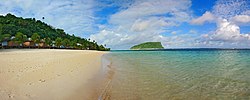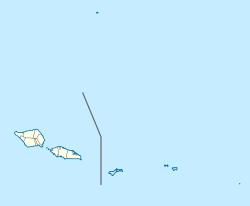Lalomanu
This article needs additional citations for verification. (August 2020) |
Lalomanu | |
|---|---|
Village | |
 | |
| Coordinates: 14°2′43″S 171°26′27″W / 14.04528°S 171.44083°W | |
| Country | |
| District | Atua |
| Population (2016) | |
| • Total | 712 |
| Time zone | -11 |
Lalomanu is a village on the east coast of Upolu island in Samoa.The village is part of the electoral constituency (Faipule District) Aleipata Itupa i Luga which is within the larger political district of Atua.[1] It has a population of 712.[2]

The white sandy seaside is called Lalomanu Beach, one of the most popular beaches in Samoa with beach fale accommodation run by locals, including Litia Sini Beach Resort and Taufua Beach Fales, for tourists and visitors. The beach has rich coral lagoons and one of the best views in Samoa. From the beach one can view the uninhabited Nu'utele Island, off the coast from the village. There are activities like snorkeling and sea kayaks available in the area. A beautiful church of the Congregational Christian Church of Samoa is located in the center of the village. The intricate patterns of the previous sanctuary's ceiling was kept intact with supporting mounts while the new sanctuary was built around it, then it was lowered in place.
Lalomanu is approximately 1 hour and 15 minutes drive from the Apia, the country's capital.
The village is the base of the Ao o Atua, where the Paramount Chief of the district of Aleipata - FUATAGA resides, ‘le Afioga ile Tui Atua Fa'anofonofo, le Tofā ile Matua ia FUATAGA’.
Leifi-le-Taua is the son of Lufasiaitu, mentioned in the old tale of Lu and his sacred hens, Samoa. The title is approximately 2,000 years old and has over 75 generations of title holders till today.
2009 Samoa tsunami[edit]

Lalomanu was heavily damaged in the 2009 Samoa tsunami with fatalities following an earthquake south of the Samoa Islands on 29 September 2009.[3] However, the village has slowly recovered in a rebuilding programme with international aid and support.
See also[edit]
References[edit]
- ^ "Samoa Territorial Constituencies Act 1963". Pacific Islands Legal Information Institute. Archived from the original on 5 June 2011. Retrieved 19 December 2009.
- ^ "Census 2016 Preliminary count" (PDF). Samoa Bureau of Statistics. Retrieved 2 August 2021.
- ^ "Deadly tsunami strikes in Pacific". BBC News. 30 September 2009. Retrieved 7 May 2010.


